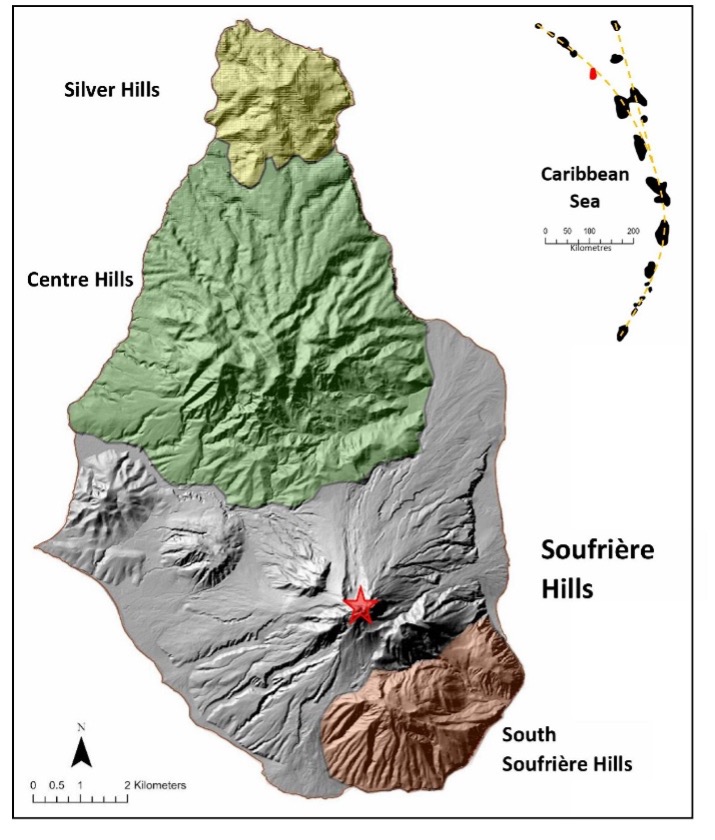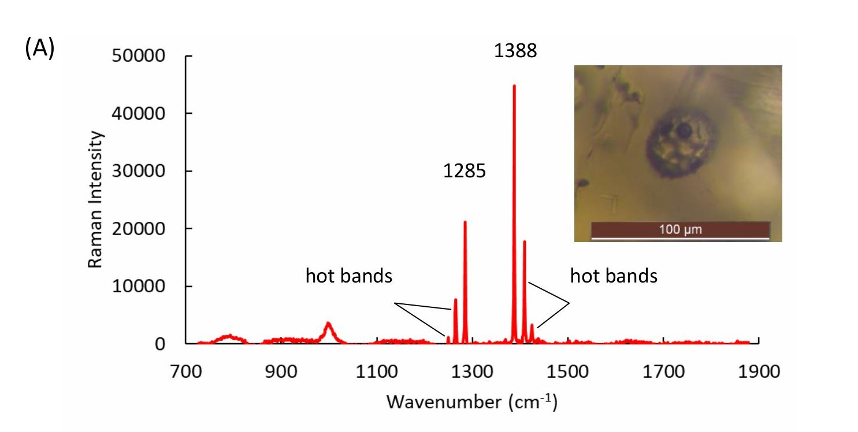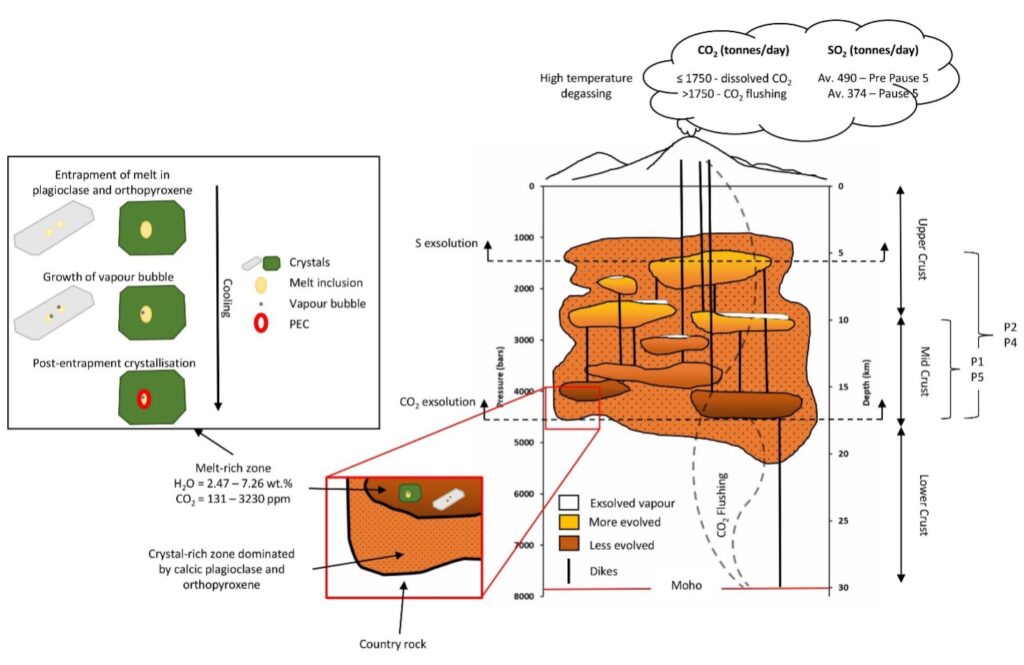It has been 30 years since the Soufrière Hills Volcano began its most recent eruptive episode in the Caribbean Island of Montserrat. This was commemorated in the recently concluded SHV30 conference. As we reflect on the scientific advances driven by this volcano, we are delighted to feature new research by Dr TiVonne Howe, Montserrat’s first female volcanologist.

TiVonne Howe
Volatile species can be dissolved in magma deep within volcanic systems, exsolving to form gases at low pressures near the surface. Carbon dioxide (CO2) is a key magmatic volatile contributing to the carbon cycle and influencing global climate. Alongside water (H2O), these volatiles play an important role in regulating the storage, ascent, and eruptibility of magma. During my PhD at Lancaster University, UK (where I also did my Master’s in Volcanology), I looked closely at magmatic CO2 in volcanic systems of the Lesser Antilles, particularly Soufrière Hills Volcano, Montserrat (Fig. 1) – the volcano with which I grew up.

Soufrière Hills Volcano is one of three volcanoes in the Lesser Antilles arc to have erupted in the last 100 years. Beginning in 1995, Soufrière Hills went through five phases of eruption, marked by lava extrusion which spanned 15 years up until 2010. In the 15 years since, the volcano has been in a state of uneasy unrest.
On the 30th anniversary of the first explosions at Soufrière Hills Volcano, we are mindful of her history. Soufrière Hills Volcano is known to exhibit signs of unrest on roughly 30-year cycles. During historical times, there were three instances of volcano-seismic crises – 1897 to 1899, 1933 to 1935 and 1966 to 1967 – where volcano-tectonic earthquakes, deformation, and enhanced fumarolic activity were signs of failed eruptions as magma failed to reach the surface.
While Soufrière Hills Volcano has been extensively studied over the last 30 years, some significant technical advances are yet to be applied to this system to accurately constrain its volatile budget. One such advance is the use of Raman spectroscopy to measure volatiles in vapour bubbles from magmatic melt inclusions. Magmatic melt inclusions, which are small parcels of melt trapped within minerals during crystallisation, can capture snapshots of the pre-eruptive magma and give insight into volatile flux and subsurface storage within plumbing systems. For Soufrière Hills Volcano, work on melt inclusions has focused solely on the glass portion of the inclusion. When only the glass is considered, crystallisation depths inferred from measured CO2 and H2O concentrations ranged between 5 and 6 km – estimated depth of magma storage. However, we are increasingly recognising that almost all magmatic CO2 in melt inclusions resides in tiny vapour bubbles generated post-entrapment, implying that previous magma storage depths are underestimates. The bubble component must therefore be added before melt inclusion CO2 contents can be used to infer magma storage depths. In our recent Frontiers paper, we use Raman spectroscopy to collect the first measurements of this “missing” CO2 residing in vapour bubbles, adding it to the glass CO2 concentrations measured by ion microprobe (Fig. 2). This approach has been adopted by others for several volcanic systems but has never been previously applied to Soufrière Hills Volcano.

After re-quantifying the total CO2 and H2O contents within melt inclusions, we found that indeed, up to 99% of the magmatic CO2 was sequestered into the bubbles. Using the solubility relationship between H2O and the total (glass + bubble) CO2 concentration, we calculated the saturation pressures for plagioclase and orthopyroxene-hosted melt inclusions in products from four of the five eruptive phases. As expected, the extra CO2 in bubbles led us to estimate significantly greater pressures, corresponding to depths between 5 and 17 km (Fig. 3). This broad depth range speaks to a vertically extensive, transcrustal magmatic system beneath Soufrière Hills. This insight places new perspective on the origin of unrest signals such as deformation, which point towards magma injection in the lower crust at ~17 km.
Using the maximum measured CO2 content from melt inclusions and the volume of magma erupted in Phases 1, 2, 4 and 5, we estimated that 4.5 Mt of CO2 would have had to have been dissolved in the magma. We use this to infer that the maximum CO2 that could be degassed from a batch of Soufrière Hills magma is 1500-1750 tonnes/day. This is far less than measured values in the plume during routine monitoring (up to ~5500 tonnes/day), advocating for CO2 flushing from deeper within the plumbing system making up the difference.

This study highlights the importance of quantifying the total melt inclusion volatiles at Soufrière Hills to gain a fuller understanding of its magmatic plumbing system. It also emphasises why we must continue to carefully monitor the CO2 flux, in addition to more routinely measured volatiles such as SO2, as it may reveal stealthy magma movement beneath our island. Will there be any significant changes of CO2 emission over the next thirty years? We don’t know yet, but melt inclusions are the closest that we come to a crystal ball!

TiVonne has just completed her PhD at Lancaster University in the UK. During her PhD, she investigated magma storage conditions and deep volatile degassing at two arc volcanoes in the Lesser Antilles. Her research interests remain volatile focused, from information obtainable through their dissolution in magmas to their release through surface emissions.
Would you like to be featured on our blog?
We’re on the hunt for fellow VIPS enthusiasts to share their stories, whether you’re a student, an early career researcher (ECR) or more experienced researcher – we want to hear from you!
Do you have a new paper to tell the world about? Or have you been involved in some exciting fieldwork recently? Get in touch at info@vipscommission.org to tell us what’s going on in your field of VIPS.

 Introducing our new VIPS President: An Interview with John Browning
Introducing our new VIPS President: An Interview with John Browning
Leave a Reply